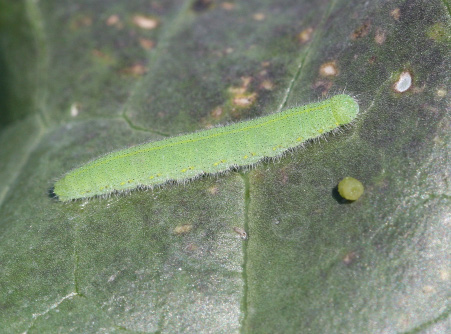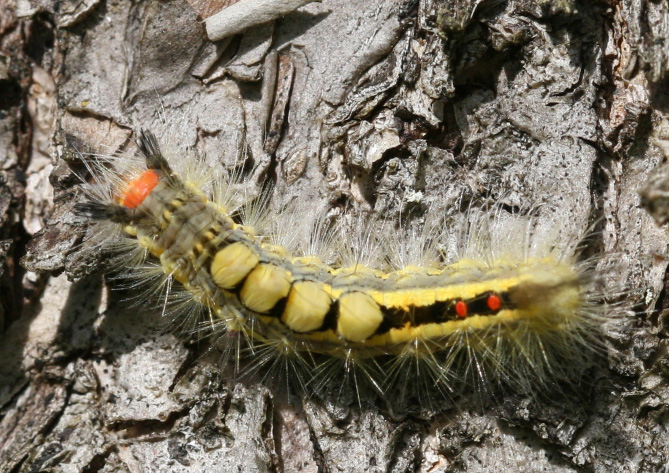The variety of insecticides available today is much greater than it was 20 years ago. It includes some made from bacteria, insect-killing fungi or viruses; products such as insecticidal soaps that kill by physical processes; and products like the clay-based Surround that don’t directly kill insects, but protect plants.
Most of the insecticides in common use today are toxic to people as well as well as insects, although the degree of toxicity to people depends on the dose of the material and the mechanism of action, among other factors.
Some toxicants affect the nervous system. Others affect water balance, oxygen metabolism, an insect’s molting or maturation process, or other aspects of physiology. Some of the newer insecticides have toxicity mechanisms that scientists don’t fully understand. New materials are being synthesized and tested constantly.

Many common insecticides in general use fit into the following classes:
Organophosphates (OP) Chlorpyrifos and malathion are organophosphates. They interfere with the transmission of nerve impulses. Their point of action is the synapse, the tiny gap between one nerve fiber and the next. Nerve impulses jump such gaps with the aid of chemicals called neurotransmitters. Enzymes normally destroy these chemicals immediately after the nerve impulse crosses the gap. Among the most common neurotransmitters is acetylcholine, which functions in our bodies the same way as it does in insects. The enzyme that breaks it down is acetylcholinesterase. OP insecticides function by inhibiting the action of the enzyme. This causes the acetylcholine to remain coupled to the nerve cell, causing the cell to fire repeatedly. Hyperactivity, uncoordinated movements, tremors, convulsions or paralysis are symptoms.
Carbamates
Carbaryl, bendiocarb, and propoxur are examples of carbamates. Like the organophosphates, carbamates act as cholinesterase inhibitors, and insects exposed to them show similar symptoms. Unlike the OP’s, the action of carbamates can be reversed.
Pyrethroids
Permethrin, cypermethrin, fenvalerate and cyfluthrin are all examples of pyrethroids. The first pyrethroids were synthesized by chemists who studied the structure of insecticidal pyrethrins, chemicals found in the seeds of certain chrysanthemums. Pyrethroids last longer than their natural counterparts and seem to have a similar mode of action, disrupting the normal transmission of nerve impulses by affecting the potassium or sodium ion channel in nerve cells.
Insect Growth Regulators (IGRs)
Methoprene and pyriproxifen are examples of IGRs. Insects go through a process of growth and development that necessitates molting, a process of shedding the “skin” and growing a new one. Some molts also result in a change in form — a caterpillar changes to a chrysalis, for example. Certain hormones control the entire process of molting and changing form. IGRs mimic those hormones or their actions. This results in changes that cause the insects to die, such as trying to change into an adult or pupa when the insect is not physiologically ready. IGRs only affect immature insects. If you expose adult insects to IGRs, they show no effect. Since humans don’t have these insect hormones, IGRs appear to have a wide margin of safety for people.

strains of B.t. insecticides. Photo: Alan T. Eaton.
Chlorinated Hydrocarbons
Methoxychlor and dicofol are examples of this group. These chemicals interfere with the normal movement of potassium and sodium ions across nerve cell surfaces. This prevents normal nerve cell function and produces symptoms similar to those from OP and carbamate insecticides.
Microbial Insecticides
These are made from microorganisms that attack insects. They are so specialized to attack insect cuticle and cells that they are not very dangerous to people.
Insecticides based on viruses must be eaten by insects in order to harm them. Then the viruses take over the function of certain insect cells (those of the gut fist), making many copies of themselves. As a result, the insect’s cells burst and die. Elcar and Madex are examples of insecticides with insect viruses as their active ingredient.
Insecticides based on the bacterium Bacillus thuringiensis also need to be eaten by insects in order to work. The microbes attack the gut lining, and then invade the insect’s body and multiply. Examples are Dipel and XenTari. Most B.t. insecticides are made from strains that harm only caterpillars. A few are available that harm immature fungus gnats or mosquito and black fly larvae, and not caterpillars. If you use a B.t. product that targets caterpillars, learn how to distinguish sawflies from caterpillars. Sawflies will not be harmed by these materials.
Fungal insecticides attack insects from the outside. The spores land on the insect’s body and grow right into it, eventually penetrating inside and growing throughout the body. Th ey require relatively high humidity to germinate and grow into the insect’s body. Examples include Met52 and Botanigard.
Other Insecticides
Fipronil is a relatively new chemical insecticide used to control some crop pests and parasites of pets. Its site of action is nerve cells, where it blocks the GABA-regulated chloride channel. This disrupts normal nerve function. Avermectins have this same mode of action.
Soaps are often thought of as “non-chemical” insect controls, but they are still composed of chemicals, usually potassium salts of fatty acids. When soaps contact the outer body covering of insects, they penetrate and dissolve into nearby cells, especially those lining the tracheoles (breathing tubes). The cell fluids leak out, and the cells collapse, plugging the tubes.
Oils sprayed on mite and aphid eggs are designed to kill the eggs by smothering them, preventing exchange of oxygen.
Essential oils are produced by certain plants, and increasingly they are being used in insecticides. Their exact function is not completely understood. An example is Essentria.
Photo: Alan T. Eaton.
Pesticide Laws
Summarizing the federal and state laws and regulations that govern the registration, transportation, use, storage and disposal of pesticides would take several pages. Here are a few general comments:
Pesticide labels are legal documents developed after much study and negotiation by lawyers and regulators, who develop the exact wording, size of letters, color and other label characteristics. It is a violation of both federal and state pesticide laws to use any pesticide “in a manner inconsistent with its labeling”.
Pesticide laws are meant to protect all of us and our environment from harm while allowing for the control of pests. It is essential that pesticide users do exactly as is prescribed on the label. When you use a pesticide on a crop or site (indoors as compared to outdoors) not specified on the label, or apply a pesticide at a higher rate than the label directs, you are not only breaking laws, you may be endangering yourself, your family, the environment. In fact, you may even be getting poorer pest control. (For NH people without a pesticide applicator license, it is illegal to apply a pesticide for a pest that is not listed on the label.) If you want more information on pesticides and their toxicity consult the Extension Toxicology Network, a collaborative project of several state universities. http://extoxnet.orst.edu/
Download the Resource to see the complete fact sheet.
